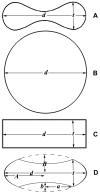A Simplified Method for Calculating Surface Area of Mammalian Erythrocytes
- PMID: 38392685
- PMCID: PMC10891711
- DOI: 10.3390/mps7010011
A Simplified Method for Calculating Surface Area of Mammalian Erythrocytes
Abstract
Knowledge of the geometric quantities of the erythrocyte is useful in several physiological studies, both for zoologists and veterinarians. While the diameter and volume (MCV) are easily obtained from observations of blood smears and complete blood count, respectively, the thickness and surface area are instead much more difficult to measure. The precise description of the erythrocyte geometry is given by the equation of the oval of Cassini, but the formulas deriving from it are very complex, comprising elliptic integrals. In this article, three solids are proposed as models approximating the erythrocyte: sphere, cylinder and a spheroid with concave caps. The volumes and surface areas obtained with these models are compared to those effectively measured. The spheroid with concave caps gives the best approximation and can be used as a simple model to determine the erythrocyte surface area. With this model, a simple method that allows one to estimate the surface area by knowing only the diameter and MCV is proposed.
Keywords: MCV; RBC; area; mammals; red blood indices; volume.
Conflict of interest statement
The authors declare no conflict of interest.
Figures





Similar articles
-
The effect of macrocytosis on rat erythrocyte deformability during recovery from phenylhydrazine-induced anemia.Biorheology. 1990;27(1):21-37. doi: 10.3233/bir-1990-27103. Biorheology. 1990. PMID: 2361163
-
Geometry of neonatal and adult red blood cells.Pediatr Res. 1983 Apr;17(4):250-3. doi: 10.1203/00006450-198304000-00003. Pediatr Res. 1983. PMID: 6856385
-
Some red blood cell geometry.Can J Physiol Pharmacol. 1983 Jun;61(6):646-9. doi: 10.1139/y83-099. Can J Physiol Pharmacol. 1983. PMID: 6883214
-
More numerical results on red blood cell geometry.Jpn J Physiol. 1984;34(2):357-60. doi: 10.2170/jjphysiol.34.357. Jpn J Physiol. 1984. PMID: 6471615
-
Associations between single nucleotide polymorphisms and erythrocyte parameters in humans: A systematic literature review.Mutat Res Rev Mutat Res. 2019 Jan-Mar;779:58-67. doi: 10.1016/j.mrrev.2019.01.002. Epub 2019 Feb 2. Mutat Res Rev Mutat Res. 2019. PMID: 31097152
Cited by
-
An on-chip deformability checker demonstrates that the severity of iron deficiency is associated with increased deformability of red blood cells.Sci Rep. 2025 Jun 6;15(1):19994. doi: 10.1038/s41598-025-05483-2. Sci Rep. 2025. PMID: 40481296 Free PMC article.
References
-
- Beltran J.F., Recio M., Aza C. Hematological and serum chemical characteristics of the Iberian lynx (Lynx pardina) in south-western Spain. Can. J. Zool. 1991;169:840–846. doi: 10.1139/z91-127. - DOI
-
- St Aubin D.J., Deguise S., Richard P.R., Smith T.G., Geraci J.R. Hematology and plasma chemistry as indicators of health and ecological status in Beluga whales, Delphinapterus leucas. Arctic. 2001;54:317–331. doi: 10.14430/arctic791. - DOI
LinkOut - more resources
Full Text Sources
Miscellaneous

